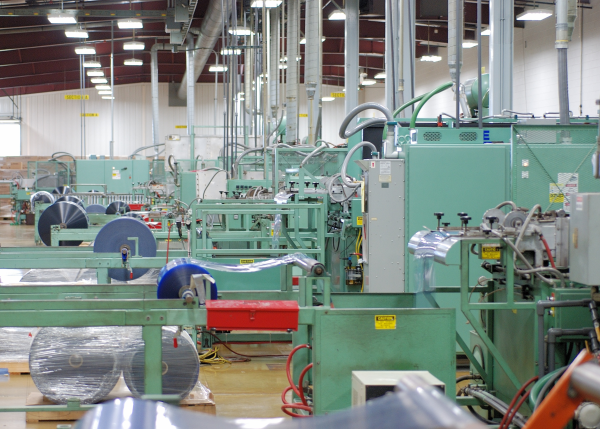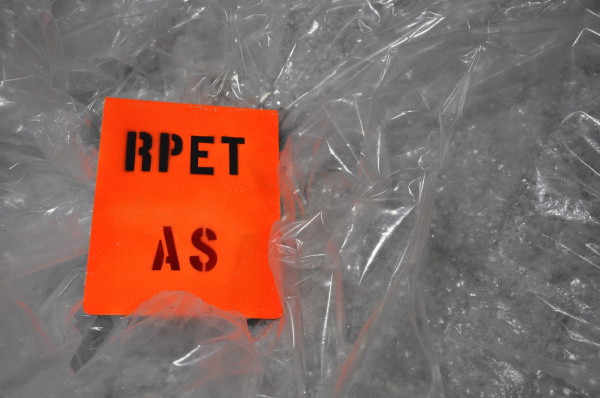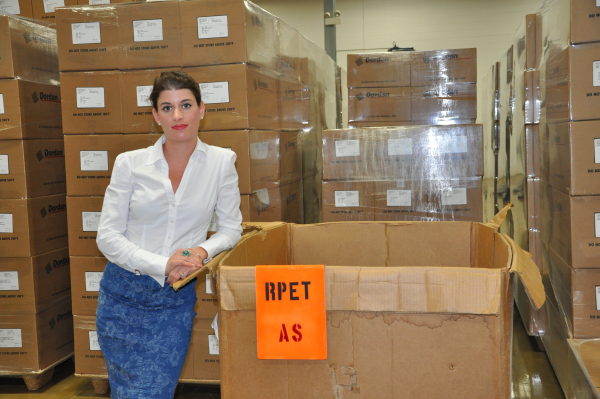Hey! Holey Toledo I have done it. After a week of interviews followed by a week of hair pulling and face-holding, I have finished Recycling Report: The State of PET Thermoform Recycling, Past, Present and Future.
This Report will be published in the August issue of Plastics in Packaging, and I just heard from the Editor that they have selected my story as THE story—I get another cover baby yea! How totally awesome is that?!?
I would like to give a special thanks to all the people who contributed their time and assistance to helping me get it right: Scott Mouw, Recycling Program Director of North Carolina, Patty Moore of Moore Recycling Associates and Resa Dimino and Kate Eagles of NAPCOR. Thanks too to representatives at Reclay StewardEdge, Klockner Pentaplast, Wellman Plastics Recycling, CalRecycle, the American Chemistry Council, Environmental Packaging International, and Avery Dennison.
The State of Post Consumer PET Thermoform Recycling: Past, Present, and Future
Prepared for Plastics in Packaging by Chandler Slavin,
Dordan Manufacturing Co. Inc.
In 2010, I published Recycling Report: the Truth about Blister & Clamshell Recycling in America with Suggestions for the Industry©[1]; I was 23 and had joined the family company Dordan Manufacturing, a plastics thermoformer based outside Chicago, IL. Therein I stated that contrary to popular belief, PET clamshells and blisters are not “recyclable” as per the FTC Green Guides’ definition. This was because 60% or more American communities did not have access to facilities that recycle PET thermoforms, only bottles[2]. I wondered, if we manufacture post consumer RPET clamshells out of 100% post consumer RPET bottles, why couldn't we recycle PET/RPET thermoforms with PET/RPET bottles? I conclude the Report by offering suggestions for how to alleviate some of the barriers to post consumer PET thermoform recycling, which can be summarized as follows: If the cost of collection, recycling and remanufacture is less than or equal to the cost of virgin material/product production, then it is likely that said type of material/packaging type will become recyclable with investment in infrastructure, sorting technologies, consumer outreach, and domestic end markets.
Fast-forward to 2012 and the publication of Moore Recycling Associates’ Plastic Recycling Collection National Reach Study, which finds that “at least 94% of the US population has access to PET bottle recycling and just over 57% has access to…all plastic bottles and all non bottle rigid container recycling”[3]. This means that in just several years, PET thermoformed containers—like the clamshells and blisters Dordan manufacturers—went from being largely landfilled to collected for recycling in the majority of American communities; or does it? The following report looks to present an accurate portrait of the state of post consumer PET thermoform container recycling: past, present and future. Through interviews with PET stakeholders and recycling thought leaders on progress in PET thermoform recycling, commonalities surfaced, which when analyzed, yield interesting implications for the PET, and larger plastics, recycling industries.
Market drivers for Post Consumer PET thermoform recycling
NAPCOR is and has been the largest advocate for the PET industry. Its membership comprises many PET resin suppliers, bottle manufacturers, thermoform and sheet converters, and reclaimers in North America, and one of its goal is to facilitate the sustainable use of PET packaging, including its recovery. As such, it practically founded the PET bottle-recycling infrastructure in the 1980s, working with stakeholders to eliminate the barriers to its efficient collection and reprocessing. Decades later and with 23 PET reclaimers online in 2011, NAPCOR reports a domestic capacity to process 1.755 billion pounds of RPET annually[4], with 5.478 billion pounds of PET bottles produced and available for recycling in the US[5]. With over 90% of American communities having access to PET bottle recycling[6], anyone in an economics 101 class would conclude that a market driven, supply/demand equilibrium could be attained for post consumer PET recycling. In other words, the increased demand for PC PET by domestic reclaimers would signal to the market that it should produce more PET bales, which would motivate communities to collect more PET. But, with a recycling rate hovering below 30%[7] and plunging bale yields due to a variety of factors, there is simply not enough PC PET available to meet the demand. NAPCOR summarizes,
The US now has capacity to process more PC PET packaging than the amount collected. That means that in 2012, even if no PET bales are exported[8] these reclamation assets will be short of material. Investments in these assets are substantial and arguably the most sophisticated in the world…without reclamation plants there is no PET recycling, and these new plants are essential if respectable PET recycling rates are to be achieved. But without additional collection efforts or new streams of material, the increased capacity will only serve to drive prices to unsustainable levels[9].
Years of excessive demand and limited supply have resulted in poor quality bales dominating the market. NAPCOR reports that US reclaimers claimed yield losses ranging from 25% for deposit bottles to 35% for curbside material and 28.9% for California CRV[10]. Moreover, while collection of PC PET has increased, the amount of useable RPET has been flat lining since 2008[11]. NAPCOR warns, “These contamination levels are higher in all categories than in 2010 and have reached crisis levels according to industry experts”[12]. Additional reasons for the declining PET utilization rates[13] include: excessive container light-weighting, brands neglecting APR’s Design for Recycling Guidelines (full-wrap bottle labels); and, more community programs switching to single-stream recycling, which while increasing the amount of material collected, also increases the level of contaminates entering the system[14].
How do you increase post consumer PET collection and RPET utilization in order to balance the supply/demand equation of PET recycling? There are many arguments: implement public policy, limit international exports, increase MRF efficiency, utilize Design for Recycling Guidelines, increase consumer convenience and participation, and, recycle all PET containers, which requires the confluence of all aforementioned efforts.
Post consumer PET thermoform recycling today
Since 2009 it has been widely recognized that adding post consumer PET thermoforms to the PET recycling infrastructure would increase the material available for reprocessing; hence, aid in achieving a sustainable economic model for PET recycling. Consequently, working groups along the supply chain have sprung to action, tackling everything from issues of contamination to issues of supply. The efforts have been far reaching and the progress in recycling PET thermoformed containers tremendous. NAPCOR summarizes,
2011 saw the first significant amount of PET thermoformed packaging moving through the system in both the US and Canada. Since 2009, NAPCOR has made the removal of obstacles to PET thermoform recycling its top priority, not only as a reflection of proper stewardship for PET’s fastest growing packaging segment, but as a way of increasing feedstock opportunities for reclaimers, and ultimately ensuring more RPET flake and pellet supply to end users. These efforts are bearing fruit, as all purchasers and processors of curbside bales are allowing some level of thermoforms mixed in with the bottles…In the short-term, increased PET thermoform collection is the best hope of addressing the key issue of increasing supply[15].
NAPCOR estimates that there are approximately one billion pounds of PET thermoforms available for recycling in North America[16]; in 2011, 45 MMlbs of PET thermoforms were recycled, including those sold to international markets as part of mixed bales[17]. With 2011 NAPCOR survey respondents indicating that all but two domestic reclaimers were purchasing PET bales with up to 10% PET thermoform content,[18] it is the thermoforming industry’s hope that it is only a matter of time until PET thermoforms are recycled as readily as PET bottles. That being said, it is widely understood that in order to achieve such a reality, all stakeholders must take action to ensure that PET thermoforms will not compromise the established process of PET recycling, but add to the material available for recovery and increase bale yields and RPET utilization rates.
One concern among reclaimers with adding PC PET thermoforms to PET bottle recycling is differences in intrinsic viscosity (IV); that is, a material’s integrity, it’s “gooeyness” or “flow.” With each heat impression or mechanical stress, IV is sheered off, compromising the performance of the material. That is why 100% post consumer RPET clamshells can be extremely brittle; the material has a lower IV as a result of the multiple conversion processes it endured transitioning from a blow molded PET bottle to extruded sheet to thermoformed container. Carbonated PET bottles enjoy the highest IV, followed by water bottles and PET sheet material/thermoforms. That is why “good quality dirty granulate material and deposit bottle bales continue to be in high demand and short supply, commanding a premium over curbside bales”[19]; because, the material arguably enjoys an IV appropriate for bottle-to-bottle recycling, the highest return for PET recycling. However, that is changing: solid state polymerization now grants more reprocessors more control over material IV; and, experimenting with different PET/RPET blends and recipes has allowed one global plastics supplier to offer different grades of PC/PI[20] RPET material, depending on the application[21]. The issue of IV in discussions of PET thermoform and bottle recycling will soon become a non-issue, as more reclaimers learn to work with PC PET thermoforms and material suppliers invest in the technologies and expertise to produce high performing RPET with this new and expanding feedstock[22].
One of the most enduring issues with PET thermoform recycling voiced by MRFs/reclaimers include issues of “look-a-like containers;” that is, the understanding that unlike bottles, which are almost unanimous in material, thermoformed containers are manufactured out of a variety of different resins, many of which, contaminates to PET recycling. However, one of the largest and oldest PET recyclers in America recently reported success with automatically sorting PET thermoforms from contaminating look-alikes, like PVC blisters, and is now accepting and processing bales comprised of 10% PET thermoforms, 90% PET bottles; no real complications to the existing sorting systems have been reported[23]. In addition, due to a grant from SPI in partnership with NAPCOR, Montgomery Country, Maryland, has reported success with training employees to manually separate PET containers from look-a-like contaminants[24]. Another dimensions to this issue of container non-conformity is that thermoforms do not “move down the line” at a MRF or reclaimer like PET bottles; they snag and disrupt the established sortation process, decreasing productivity.
One piloted approach to this issue of container look-a-like occurred in June 2011, when “Canada’s top five grocery chains…announced that they will require suppliers to shift to PET for clamshell thermoformed packaging in a move designed to simplify the product stream and increase recycling[25]”. By attempting to reduce the amount of non PET thermoforms sold at retail, Canadian grocers signaled to the market to trust in PET reclamation, decreasing the likelihood of contamination through container look-a-like issues.
During PET thermoform recycling pilots performed by NAPCOR and its industry allies, it was discovered that the pressure-sensitive labels used on thermoformed food containers are so aggressive that they are not removed in the washing stage of recycling, compromising the process. Consequently, APR[26] published “PET Thermoform Label and Adhesive Evaluation”[27], which looks to analyze the characteristics of labels/adhesives intended for use on PET thermoforms to confirm compatibility with PET recycling, though the ramifications of these guidelines have yet to manifest in the market.
2013 witnessed a revolution in the global recycling market: China, historically a major buyer of US plastic bales, began enforcing the “Green Fence;” a policy-driven attempt to reduce “dirty scrap imports” and develop China’s internal recycling markets[28]. Plastics News reports:
China’s “Green Fence” crackdown on dirty scrap materials has reduced imports of plastic waste by 5.5 percent in the first four months of the year… Imports of scrap plastic bound for recycling factories in the country fell to 2.4 million metric tons from January through April…The disclosure of the 5.5 percent drop…is one of the first statistical indications that the Green Fence policy is having a big impact on the industry. While that drop may sound small, it’s a major change in direction for an industry that has seen scrap polymer imports grow four-fold in the last decade and was accustomed to nothing but increasing volumes[29].
Imagine that you are a MRF[30] and you collect post consumer PET material for resale. With domestic demand for PET bales exceeding supply, the competition is fierce. Now marry that with the historical international demand, which prior to Green Fence did not require imported plastic bales meet quality specs, and you can begin to understand why PET bale yields and RPET utilization rates have been plunging. Why sort PET from other materials when my Chinese buyer will take all the scrap for a price competitive with what a domestic buyer is willing to pay for just the PET portion? Green Fence therefore implies that more pressure will be exerted on domestic MRFs and intermediate processors to efficiently sort PET for consumption by domestic end markets because the Far East buyer of dirty scrap bales is quickly becoming a historical relic of yesteryear’s largely unregulated market.
Post consumer PET recycling tomorrow
So here we are: we have arrived at the modern day state of post consumer PET thermoform recycling. With the majority of American communities now accepting all non-bottle rigid containers for recycling and the technical barriers to PC PET thermoform recycling being resolved, the floodgates to PET thermoform are nearly ready to be opened. While the implications of China’s Green Fence are yet to manifest in the PET reclamation market, all signs point to a stable increase in PET collection and recycling in order to continue to add to the amount of usable RPET available to secondary markets. Will recycling PET thermoforms be the silver bullet to cementing a sustainable PET recycling market? Will we soon arrive at a reality where retailer preference for post consumer PET packaging sends a signal to municipalities to invest in community collection efforts for PET packaging, thereby generating the needed supply of recycled and cost-competitive RPET for packaging manufacturers to meet the demands of its end customer? Unfortunately, the data isn’t too compelling: while we have been recycling for decades, recycling rates have plateaued, even with increased industry engagement. For some, it is believed a structural flaw is to blame; that is, a disconnect between those who sit on the supply and those who need it. North Carolina Director of Recycling Scott Mouw summarizes the tensions inherent in creating a market driven recycled commodities market utilizing the existing municipally managed collection and reprocessing schemes:
If you were going to design a responsive commodity supply system, why would you rely on decision-makers who appear unmotivated by prices, have competing internal investments and are essentially unrewarded by the market place? And why would you set up a system in which the cost of collection is not remotely covered by system income?[31]
Discussions with key stakeholders have led me to conclude that there are three prevailing perspectives about the likelihood of creating a market-driven and sustainable PET recycling market: (1) Those who believe it is completely possible to develop a sustainable PET recycling market based on real market drivers with enhanced consumer education and Best in Class package design and recovery processes; (2) Those who believe it is possible to develop a sustainable PET recycling market with governmental intervention aimed at incentivizing collection and recycling, like landfill bans or bottle deposit legislation; and (3), those who do not believe it is possible to develop a market driven PET recycling market where the cost of recycling is competitive with the cost of virgin material production and attest that recycling will always be a cost to the system; the question now is, whose cost?
In my 2010 Recycling Report© I argue that a sustainable model for post consumer PET recycling can be reached, assuming that the cost of collection, reprocessing and remanufacture is less than or equal to that virgin PET production. With the fossil fuel crisis in fuel swing and American boots on the ground overseas to protect these assets, the idea that recycled PET could become cost competitive with virgin PET was not uncharted territory. I intended to conclude this Report with the same argument made in the first, though strengthened further with the recent acquisition of PET thermoforms to the majority of American community recycling programs. However, conversations with stakeholders on my journey to understand the state of PET thermoform recycling coupled with our new access to natural shale gas deposits only further complicates the issue of achieving a market-driven PET recycling market in North America, independent of public policy measures. Regardless of which camp you reside in, however, I believe we all can agree that there is no plastics sustainability without recycling. Moreover, I believe it best to be proactive when dealing with issues of environmental protection, lest you be caught off guard with irrational regulatory mandates, like bag bans. By being present in the dialogue on plastics recycling and sustainability, plastic stakeholders can benefit from the value of collaboration, best manifest through the development of real, end of life management options for all plastic packaging.
[1] Recycling Report© was the result of over a year of independent research on recycling catalyzed by serving as Walmart Canada’s co-lead of the PET Subcommittee of the Material Optimization Committee (2009-2010). The Report first appeared in a Packaging World eBlast (4/2010) followed by publication in abstract in Plastics News and Pira International (11/2010) as preview for my presentation at Sustainable Plastics Packaging (2/2011). Versions thereof where subsequently published in Packaging Digest (2/2011) and Plastic Technology (3/2011) and again previewed by Just Means for my presentation at Sustainability in Packaging (5/2011). These efforts were awarded with the cover of Green Manufacture in fall 2010, http://www.greenmanufacturer.net/article/materials/thermoformer-chases-chasing-arrows--recycling-symbol.
[2] The FTC “Green Guides” attempt to reduce confusing surrounding environmental marketing claims by providing a template for communicating environmental credentials to consumers. For one to claim a package is “recyclable” one must demonstrate that the majority of US population (>60%) has access to facilities that can recycle said package, (http://www.ftc.gov/opa/2012/10/greenguides.shtm).
[3] Moore Recycling Associates Inc., Plastic Recycling Collection National Reach Study: 2012 Update, February 2013, p. 5, http://www.moorerecycling.com/m_02_00.html.
[4] NAPCOR, 2011 Report on Postconsumer PET Container Recycling Activity, released October 2012, p. 6, http://www.napcor.com/PET/pet_reports.html.
[8] “Exports to the Far East totaled 634 MMlbs, or 39.5% of the PET bottles collected. This represents the smallest presence of exporters in the market since 2005 and reflects increased investment in domestic reclamation capacity” (NAPCOR, p. 3).
[11] Resa Dimino, Director of Public Policy at NAPCOR, Why Consider EPR for Packaging? An Industry Perspective, presented at Federation of NY Solid Waste Association’s Annual Conference, May 2013, slide #8.
[13] “PET utilization rate is determined by adding the amount of clean flake produced by US reclaimers, the amount produced by Canadian reclaimers from US bottles, and the amount exported to be produced from exported bottles; the sum is expressed as a percentage of total US bottles available for recycling” (NAPCOR, p. 7).
[16] Dan Mohs, CEO of Madison-based thermoform Placon, Retail Thermoforms, A Never Ending Story, presented at Waste Expo, May 2013, slide #9.
[22] Phone interviews with domestic recyclers of PET for bottle-to-bottle and bottle-to-sheet processes, May 27-May 31, 2013.
[25] “Canadian retailers address PET thermoform recycling, Greener Package, August 11, 2011, http://www.greenerpackage.com/recycling/canadian_retailers_address_pet_thermoform_recycling.
[26] Association of Postconsumer Recyclers, http://www.plasticsrecycling.org/.
[27] Evaluation details accessible here: http://www.plasticsrecycling.org/pet-thermoforms.
[28] Phone interview with Mustan Lalani, Project Manager at Reclay StewardEdge Inc., June 3, 2013, http://reclaystewardedge.com/.
[29] Steve Toloken, staff reporter, Plastics News, “China’s ‘Green Fence’ makes unprecedented cuts in recycled plastic imports,” May 19, 2013, http://www.plasticsnews.com/article/20130519/NEWS/130519922/china-s-green-fence-makes-unprecedented-cuts-in-recycled-plastic-imports.
[31] Scott Mouw, North Carolina Recycling Program Director, “Running to stand still: Why the current municipal recycling system can’t deliver the goods,” Product Policy Institute Blog, May 31, 2012, http://productpolicy.blogspot.com/2012/05/running-to-stand-still-why-current.html.
Photos to run with the story:

Above: plastics thermoforming at Dordan Manufacturing

Above: ground post industrial RPET @Dordan ready for recycling

Pictured: ME hanging out by the RPET gaylord @Dordan. I heart recycling!

New and improved head-shot for Plastics in Packaging feature!
